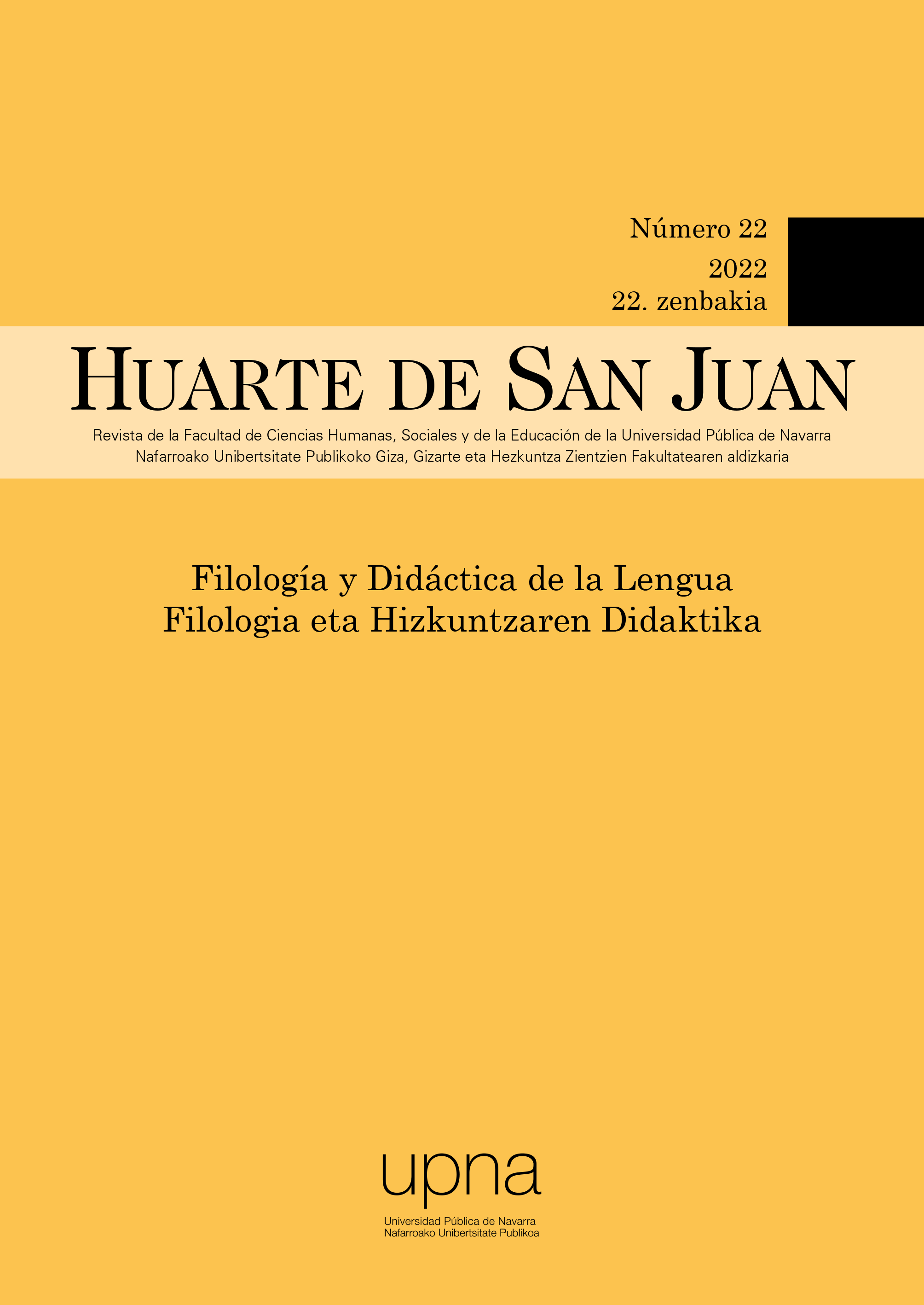Enseñanza de los pronombres de objeto directo e indirecto en español a través de un enfoque apoyado en tareas por videoconferencia
DOI:
https://doi.org/10.48035/rhsj-fd.22.6Palabras clave:
Enfoque apoyado en tareas, Adquisición de gramática, Educación por videoconferenciaResumen
La enseñanza de idiomas a través de
un enfoque apoyado en tareas por videoconferencia
enfatiza la importancia del alumno y el
aprendizaje experimental en la adquisición de
un segundo idioma. Aún sabiendo esto, relativamente
pocos estudios han abordado la adquisición
de gramática en cursos en línea desde
una perspectiva basada en tareas. El presente
estudio examina los efectos de un módulo en línea
diseñado para la enseñanza de pronombres
de objeto directo e indirecto en español a través
de videoconferencia. Estos pronombres son
utilizados con mucha frecuencia por los hispanohablantes,
pero son difíciles de adquirir para
los estudiantes de español. Los participantes
de este estudio utilizaron los pronombres de
objeto directo e indirecto en muchas ocasiones
sin que se les solicitara hacerlo. Los resultados
sugieren que el módulo en línea utilizado en
este estudio presenta un enfoque prometedor
para la enseñanza de la gramática.
Descargas
Citas
Baralt, M. (2014). Task sequencing and task complexity in traditional versus online classes. In M. Baralt, R. Gilabert, & P. Robinson (Eds.), Task sequencing and instructed second language learning (pp. 95– 122). Bloomsbury.
Baralt, M., Gurzynski-Weiss, L., & Kim, Y. (2016). Engagement with language: How examining learners’ affective and social engagement explains successful learner-generated attention to form. In M. Sato & S. Ballinger (Eds.), Peer interaction and second language learning. Pedagogical potential and research agenda (pp. 209-240). John Benjamins.
Canale, M., & Swain, M. (1980). Theoretical bases of communicative approaches to second language teaching and testing. Applied Linguistics, 1(1), 1–47.
Canals, L., & Mor, Y. (2020). Towards a Signature Pedagogy for Task-Based Technology-Enhanced Language Learning: Design Patterns. Proceedings of the European Conference on Pattern Languages of Programs 2020 (EuroPLoP ’20) (pp. 1–11). NY, USA. https://doi.org/10.1145/3424771.3424787
Celce-Murcia, M. (1991), Grammar Pedagogy in Second and Foreign Language Teaching. TESOL Quarterly, 25, 459-480. https://doi.org/10.2307/3586980
Chen, M. & Li, W. (2022) The Influence of Form-Focused Instruction on the L2 Chinese Oral Production of Korean Native Speakers. Front. Psychol. https://doi.org/10.3389
Dörnyei, Z. (2007). Research methods in Applied Linguistics. Oxford University Press.
Ellis R. (1997). Second Language Acquisition. Oxford University Press.
Ellis, R. (2003). Task-based language learning and teaching. Oxford University Press.
Ellis, R. (2009). The differential effects of three types of task planning on the fluency, complexity, and accuracy in L2 oral production. Applied Linguistics, 30, 474–509.
Kern, R., & Warschauer, M. (2008). Network-Based Language Teaching. In: Hornberger, N.H. (Eds). Encyclopedia of Language and Education. Springer. https://doi.org/10.1007/978-0-387-30424-3_105
Godev, C. B. (2014). First-year hybrid Spanish courses: How instructors manage their time. Hispania, 97, 21–31.
González-Lloret, M., & Ortega, L. (Eds.). (2014). Videoconferencing TBLT: Researching technology and tasks (Vol. 6). John Benjamins Publishing Company.
González-Lloret, M. (2016). A practical guide to integrating technology into task-based language teaching. Georgetown University Press.
Hattie, J., & Yates, G. C.R., (2014). Visible learning and the science of how we learn. Routledge.
Liceras, Juana M., Denyse Maxwell, Biana Laguardia, Zara Fernández, Raquel Fernández, & Lourdes Díaz. (1997). A longitudinal study of Spanish non-native grammars: Beyond parameters. In William R. Glass and Ana Teresa Pérez-Leroux, (Ed.). Contemporary perspectives on the acquisition of Spanish, vol. 1, Developing grammars (p. 99- 132). Cascadilla Press.
López-Burton, N., Marques, P. L., & Pardo, B. C. (2019). Pura vida: Beginning Spanish. John Wiley & Sons, Inc.
Long, M.H. (1988). Instructed interlanguage development. In L. Beebe (Ed.). Issues in Second Language Acquisition: Multiple Perspectives (pp 115-141). Newbury House.
Long, M. H. (1991). Focus on form: A design feature in language teaching methodology. In K. de Bot, R. Ginsberg, and C. Kramsch (Eds.). Foreign Language Research in Cross-cultural. John Benjamins.
Norris, J.M. (2009). Task-based teaching and testing. In M. H. & C. J. Doughty (Eds.), Handbook of language teaching (pp. 578–594). Wiley/Blackwell.
Prabhu, N. S. (1987). Second language pedagogy. Oxford University Press.
Samuda, V., & Bygate, M. (2008). Tasks in second language learning. Palgrave Macmillan.
Sanchez, L., & Tamara Al-Kasey. (1999). L2 acquisition of Spanish direct objects. Spanish Applied Linguistics 3:1-32.
Schmidt, R. (1994). Implicit learning and the cognitive unconscious: Of artificial grammars and SLA. In N. Ellis (Ed.), Implicit and Explicit Learning of Languages. (pp. 165-209). Academic Press.
Shaw, P., & Liu, E. (1998). What develops in the development of second-language writing? Applied Linguistics, 19(2), 225-254.
Skehan, P. A (1998). Cognitive Approach to Language Learning. Oxford University Press.
Spada, N., Lightbown, P., & White, J. (2005). The importance of form/meaning mappings in explicit form-focused instruction. In A. Housen, & M. Pierrard (Eds.), Investigations in instructed second language acquisition (pp. 199-234). Mouton de Gruyter. http://dx.-doi.org/10.1515/9783110197372.2.199
Swan, M. (1985). A critical look at the Communicative Approach (1), ELT Journal. 39, (1), pp. 2-12.
Tomei, L. A. (2006). The impact of online teaching on faculty load: Computing the ideal class size for online courses. Journal of Technology and Teacher Education, 14, 531–541.
Toyoda, E. (2001). Exercise of learner autonomy in project-oriented CALL. CALL-EJ Online, 2 (2), http://callej.org/journal/2-2/toyoda.html
Van den Branden, K. (Ed.). (2006). Task-based language education: from theory to practice. Cambridge.
VanPatten, B. & Sanz, C. (1995). From input to output: Processing instructional and communicative tasks. In Fred R. Eckman, Diane. Highland, Peter W. Lee, Jean Mileham, and Rita Rutkowski Weber, (Eds.). Second language acquisition theory and pedagogy (pp. 169-185). Routledge.
Willis, J. (1996). A framework for task-based learning. Longman.
Williams, M. (1994) Motivation in foreign and second language learning: an interactive perspective. Educational and Child Psychology,11, 77-84.
Worley, W., & Tesdell, L. (2009). Instructor time and effort in online and face-to-face teaching: Lessons learned. IEEE Transactions on Professional Communication, 52, 138–151.

Descargas
Publicado
Cómo citar
Número
Sección
Licencia
Derechos de autor 2022 Alexandra Lopez Vera

Esta obra está bajo una licencia internacional Creative Commons Atribución-NoComercial-SinDerivadas 4.0.
Todos los artículos son publicados bajo una licencia de uso y distribución Creative Commons (BY-NC-ND 4.0). A cada artículo se le asignará un identificador DOI.
Los autores conservan los derechos de autor y conceden a la revista el derecho de la primera publicación. Los autores podrán establecer acuerdos adicionales para la distribución no exclusiva de la versión de la obra publicada en la revista (por ejemplo, situarlo en un repositorio institucional), con un reconocimiento de su publicación inicial en esta revista. Los trabajos podrán subirse a repositorios institucionales inmediatamente tras la publicación de la revista.
Asimismo, se permite y se anima a los autores a difundir sus trabajos electrónicamente (por ejemplo, en repositorios institucionales, redes sociales académicas o en su propio sitio web).






